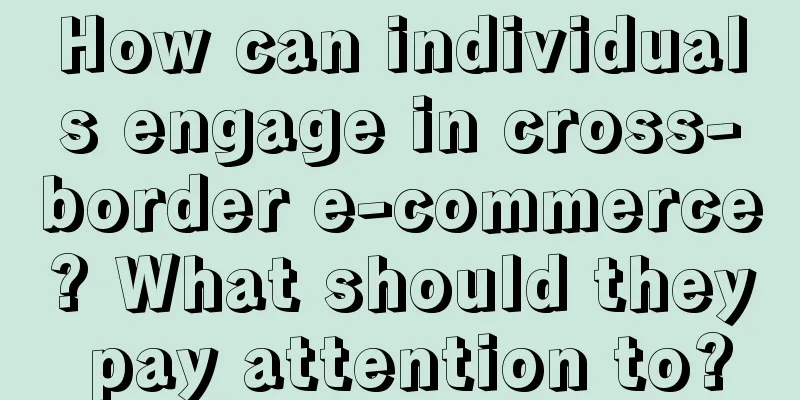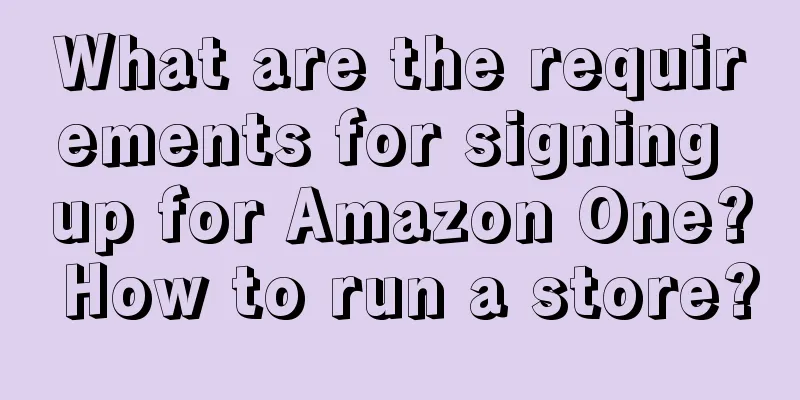How can individuals engage in cross-border e-commerce? What should they pay attention to?

|
Today, I will introduce the cross-border e-commerce industry to you. There are actually quite a lot of businesses doing this. Even individuals can choose to do cross-border e-commerce. So how do individuals do cross-border e-commerce? In order to solve your problems, the following is an introduction. How can individuals engage in cross-border e-commerce? 1. Choose a suitable cross-border e-commerce platform Get familiar with the characteristics of each platform, learn about the information around you or on the Internet, integrate resources, and see which country/region market is more suitable and which platform to enter. The mainstream e-commerce platforms include: Europe and America: Amazon, Walmart, Alipress, wish, ebay, etc.; Independent website: Shopify, Youzan Allvalue, WOOCOMMERCE, Shoplus, etc. Japan: Rakuten, Yahoo, Amazon Japan, Qoo10, etc. Southeast Asia: Shopee, Lazada, etc.; 2. Familiarity with platform rules After choosing a platform, you need to fully understand the rules of your platform. The depth of your familiarity with the rules largely determines whether you can operate the platform well, just like the principle of being familiar with the rules of a game. First, there are websites with learning on the platform itself, such as Amazon, eBay, and AliExpress, which all have corresponding basic tutorials. In addition, some will choose to build independent sites, such as Shopify’s official website, which has very detailed tutorials telling you how to build a website. Then you can go to various foreign trade forums and websites to learn, and finally use the various theories you have learned to slowly master them through specific backend operations. 3. Product Selection There are several main ways to select products. First, use the platform's front-end search for keywords, combined with relevant tools, to see the total number of such products on the shelves, the competition situation, and sales, so as to determine your own product direction; the second is to browse some foreign shopping websites to understand the website's hot-selling products, which can provide a reference for your product selection. The third is to find popular products through foreign social media, such as Facebook, Twitter, Tumblr, etc. The fourth is to search for big sellers on the platform. For example, if you want to sell a certain product category, you can search for a model store through keywords for research and analysis. Moreover, by studying the buyer page of the model seller, we can get effective information on the title, keywords, market positioning, market activity and other aspects of the popular product. 4. Find a supplier After finding the right product, you need to look for a high-quality supplier. What is a high-quality supplier? The supplier that suits me best is a high-quality supplier, and the supplier that highly matches the order is a high-quality supplier. For individuals doing cross-border e-commerce, it is recommended that you don’t have to go to great lengths to find a large upstream supplier at the beginning. You can go to 1688 and take a look, and place an order directly if you find a suitable one. 5. Store Operation and Management The operation of a store is very complicated. Not only do you need management and marketing thinking, but in the process of cross-border e-commerce operations, sellers need to deal with a variety of issues such as: reasonable product selection and stocking, market research, analysis of competitors and product historical performance, etc. If these steps are entirely analyzed by manpower, it is impossible to start and it is difficult to draw correct conclusions. Choosing a suitable cross-border operation analysis tool can help sellers get twice the result with half the effort. For example: Zebra ERP is a multi-platform cross-border e-commerce ERP and professional independent station ERP, which is connected to more than 20 platforms and independent stations such as Amazon, Shopify, and Japan Rakuten, and has developed refined operation functions for each platform, especially in the independent station, to help sellers achieve fast website building, fast procurement, and support free trial. It has intelligent product library, product listing, order management, warehouse management, procurement management, advertising management, multi-dimensional profit accounting, data reporting, operation tools, authority management and other functions. Taking the cross-border e-commerce platform Amazon as an example, if you don’t have many products, first of all, after you choose a product, you can send the product directly to the FBA warehouse in the United States. If there is an order, the American warehouse will directly help you ship the goods. You need to pay attention to your own product inventory. Recommended reading: Which platform should I choose for cross-border e-commerce? What are the requirements for entry? How to do cross-border e-commerce for individuals? What do you need to prepare? Is cross-border e-commerce profitable for individuals? How can you make money? |
<<: Category Adjustment of Alibaba International Station in October 2022
>>: What are the cross-border e-commerce logistics? Introduction to the four major models
Recommend
Lazada store opening process and cost introduction
When doing cross-border e-commerce, choosing a pla...
How to change the language on Amazon France? How to switch to Chinese?
Amazon backend supports multiple languages. For ex...
Is the Amazon Logistics New Product Warehouse Promotion Program OK? What are the benefits of joining?
As one of the world's largest e-commerce platf...
The roaring-style dog training attracted 12.5 million fans. Has the pet industry changed?
In the circle of pet lovers, the cute pet blogger ...
Why is Amazon spending too much money on advertising but not getting any sales? What are the reasons?
There are many merchants opening stores on the Ama...
Do I need a deposit to open a Shopee store? How much is the deposit?
The Shopee platform supports individuals to open s...
Pinduoduo’s standardized operation strategy
It is very necessary to learn the standardized ope...
When a large number of North Americans flock to Xiaohongshu...
As TikTok faces the risk of being banned in the Un...
How to return or exchange goods on Shopify? What are the rules?
When you shop online, if you are not satisfied wit...
How can Lazada Malaysia make orders faster? How to do it well?
Lazada is a well-developed cross-border e-commerce...
Tencent urgently needs to loosen up its video accounts
The supply-side cost is lower than that of Douyin,...
Douyin sells children's teaching aids, with sales of over 100,000
Can ordinary people do e-commerce? Recently, I dis...
Integrated brand communication: How to do communication and how to write annual report?
Brands exist in the minds of consumers, and only w...
My experience of missing five opportunities to make money from self-media
Sometimes, some opportunities are right in front o...
Meituan VS Douyin: A brief introduction to search life services VS interest life services
Douyin life service has become another large-scale...









